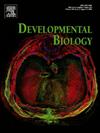A gene regulatory network for specification and morphogenesis of a Mauthner Cell homolog in non-vertebrate chordates
IF 2.5
3区 生物学
Q2 DEVELOPMENTAL BIOLOGY
引用次数: 0
Abstract
Transcriptional regulation of gene expression is an indispensable process in multicellular development, yet we still do not fully understand how the complex networks of transcription factors operating in neuronal precursors coordinately control the expression of effector genes that shape morphogenesis and terminal differentiation. Here we break down in greater detail a provisional regulatory circuit downstream of the transcription factor Pax3/7 operating in the descending decussating neurons (ddNs) of the tunicate Ciona robusta. The ddNs are a pair of hindbrain neurons proposed to be homologous to the Mauthner cells of anamniotes, and Pax3/7 is sufficient and necessary for their specification. We show that different transcription factors downstream of Pax3/7, namely Pou4, Lhx1/5, and Dmbx, regulate distinct “branches” of this ddN network that appear to be dedicated to different developmental tasks. Some of these network branches are shared with other neurons throughout the larva, reinforcing the idea that modularity is likely a key feature of such networks. We discuss these ideas and their evolutionary implications here, including the observation that homologs of all four transcription factors (Pax3/7, Lhx5, Pou4f3, and Dmbx1) are key for the specification of cranial neural crest in vertebrates.

非脊椎动物脊索动物毛特纳细胞同源物的规范和形态发生的基因调控网络
基因表达的转录调控是多细胞发育中不可或缺的过程,但我们仍然不完全了解在神经元前体中运作的转录因子的复杂网络如何协调控制影响形态发生和终端分化的效应基因的表达。在这里,我们更详细地分解了转录因子Pax3/7下游的一个临时调节回路,该回路在被囊草的下行讨论神经元(ddNs)中运作。ddNs是一对被认为与羊膜动物毛特纳细胞同源的后脑神经元,Pax3/7是其特异性的充分必要条件。我们发现Pax3/7下游的不同转录因子,即Pou4、Lhx1/5和Dmbx,调节着这个ddN网络的不同“分支”,这些分支似乎致力于不同的发育任务。这些网络分支中的一些与整个幼虫的其他神经元共享,强化了模块化可能是这些网络的关键特征的想法。我们在这里讨论了这些观点及其进化意义,包括观察到所有四种转录因子(Pax3/7, Lhx5, Pou4f3和Dmbx1)的同源物是脊椎动物颅神经嵴发育的关键。
本文章由计算机程序翻译,如有差异,请以英文原文为准。
求助全文
约1分钟内获得全文
求助全文
来源期刊

Developmental biology
生物-发育生物学
CiteScore
5.30
自引率
3.70%
发文量
182
审稿时长
1.5 months
期刊介绍:
Developmental Biology (DB) publishes original research on mechanisms of development, differentiation, and growth in animals and plants at the molecular, cellular, genetic and evolutionary levels. Areas of particular emphasis include transcriptional control mechanisms, embryonic patterning, cell-cell interactions, growth factors and signal transduction, and regulatory hierarchies in developing plants and animals.
 求助内容:
求助内容: 应助结果提醒方式:
应助结果提醒方式:


